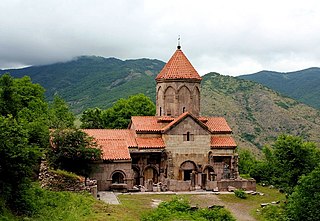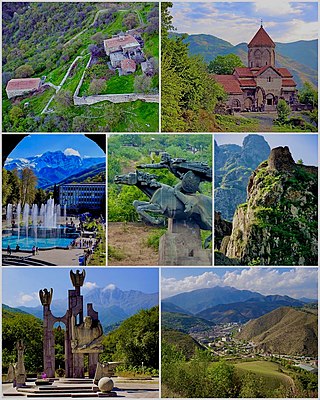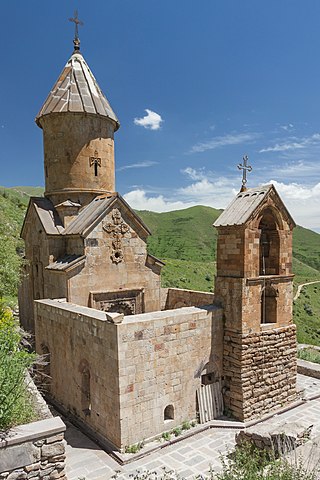
Syunik is the southernmost province of Armenia. It is bordered by the Vayots Dzor Province to the north, Azerbaijan's Nakhchivan Autonomous Republic exclave to the west, Azerbaijan to the east, and Iran to the south. Its capital and largest city is the town of Kapan. The Statistical Committee of Armenia reported its population was 141,771 in the 2011 census, down from 152,684 at the 2001 census.

Kapan is a town in southeast Armenia, serving as the administrative centre of the Kapan Municipality and also as the provincial capital of Syunik Province. It is located in the valley of the Voghji River and is on the northern slopes of Mount Khustup. Kapan is the most populous town in the Syunik Province as well as the entire region of southern Armenia. According to the 2011 census, the population of Kapan was 43,190, a slight decline from 45,711 in the 2001 census. According to the 2023 official estimate, the current population of the town is around 41,300.

Garegin Ter-Harutyunyan, better known by his nom de guerreGaregin Nzhdeh, was an Armenian statesman, military commander and nationalist revolutionary. As a member of the Armenian Revolutionary Federation, he was involved in the national liberation struggle and revolutionary activities during the First Balkan War and World War I and became one of the key political and military leaders of the First Republic of Armenia (1918–1921). He is widely admired as a charismatic national hero by Armenians.

The Armenian-Azerbaijani war (1918–1920) was a conflict that took place in the South Caucasus in regions with a mixed Armenian-Azerbaijani population, broadly encompassing what are now modern-day Azerbaijan and Armenia. It began during the final months of World War I and ended with the establishment of Soviet rule.

Sisian is a town and the centre of the Sisian Municipality of the Syunik Province in southern Armenia. It is located on both banks of the Vorotan River, at an altitude of 1600 m above sea level, 6 km south of the Yerevan-Meghri highway, at a road distance of 217 km southeast of the capital Yerevan, and 115 km north of the provincial capital Kapan.

The Republic of Mountainous Armenia, also known as simply Mountainous Armenia, was an anti-Bolshevik Armenian state roughly corresponding with the territory that is now the present-day Armenian provinces of Vayots Dzor and Syunik, and some parts of the present-day Republic of Azerbaijan in the west. It was established by military commander and Armenian political thinker Garegin Nzhdeh and his allies with the support of local guerrilla forces, following the suppression of the February Uprising in April 1921. It was not recognized by any country but existed until mid-July of the same year.

Shurnukh is a village in the Goris Municipality of the Syunik Province in Armenia.
Güznüt is a village and municipality in the Babek District of the Nakhchivan Autonomous Republic in Azerbaijan. The village is located on a plain 10 kilometres from the city of Nakhchivan, on the left side of the Nakhchivan-Julfa highway. The local economy is mainly based on grain-growing and animal husbandry. There is a secondary school, club, mosque and a medical center in the village. It has a population of 1,563. The village had an Armenian majority prior to the Muslim uprisings in Kars and Sharur–Nakhichevan.

Shengavit, is one of the 12 districts of Yerevan, the capital of Armenia, located at the southwestern part of the city. It has common borders with the districts of Malatia-Sebastia, Kentron, Erebuni and Nubarashen. Ararat Province forms the southern borders of the district.
FC Gandzasar Kapan is an Armenian football club based in the town of Kapan, Syunik Province. The team plays in Armenian Premier League. The club headquarters are located on 18 Garegin Nzhdeh street, Kapan. The Gandzasar Kapan Training Centre is located at the eastern outskirts of the town of Kapan.

Kajaran is a town and the centre of the Kajaran Municipality of the Syunik Province in southern Armenia. It is located 356 km south of the capital Yerevan, 25 km west of the provincial centre Kapan, and 50 km north of the Armenia-Iran border.

Garegin Nzhdeh Square, formerly Souren Spandaryan Square, is the second largest square in the city of Yerevan, Armenia. It is located in the Shengavit district, to the south of the city centre. The square is intersected by the following streets: Garegin Nzhdeh, Manandian, Yeghbayrutian and Bagratuniats. The square was officially opened on 30 April 1959.

Garegin Nzhdeh Square is a Yerevan Metro station. It was opened to the public on 4 January 1987 and located on Garegin Nzhdeh Square. Formerly known by the name Spandaryan Square, it was renamed as a tribute to the Armenian independence hero, Garegin Nzhdeh.

Spitakavor Monastery, is a 14th-century Armenian monastic complex, 7 kilometres (4.3 mi) north of Vernashen village, near the town of Yeghegnadzor of Vayots Dzor Province, Armenia.

The Armenian Native Faith, also termed Armenian Neopaganism or Hetanism, is a modern Pagan new religious movement that harkens back to the historical, pre-Christian belief systems and ethnic religions of the Armenians. The followers of the movement call themselves "Hetans" or Arordi, meaning the "Children of Ari", also rendered as "Arordiners" in some scholarly publications.

Nazeni Garniki Hovhannisyan is an Armenian actress, presenter and lecturer at the Yerevan State Institute of Theatre and Cinematography.

Tseghakronism is a national, ethnic and political ideology toward a renewal of the spiritual, behavioral and cultural identity of the Armenian people. The aim of Tseghakronism is to unite the Armenian people on the territory of their historical homeland within a single Armenian state.

Hayk Asatryan was an Armenian political theorist, an associate and close friend of Garegin Nzhdeh, and one of the founders of Tseghakronism and Taronism. He authored several books and articles on the history of Armenia.

The Zangezur uezd was a county (uezd) of the Elizavetpol Governorate of the Russian Empire with its administrative center in Gerusy from 1868 until its formal abolition and partition between the Soviet republics of Armenia and Azerbaijan in 1921. The area of the Zangezur uezd corresponded to most of the contemporary Syunik province of Armenia, and Lachin, Gubadly, Zangilan, and the westernmost parts of Shusha districts of Azerbaijan.
Zangezur is a historical and geographical region in Eastern Armenia on the slopes of the Zangezur Mountains which largely corresponds to the Syunik Province of Armenia. It was ceded to Russia by Qajar Iran according to the Treaty of Gulistan in 1813. In Soviet times, the Goris, Kapan, Meghri and Sisian regions of the Armenian SSR were located within Zangezur, which in 1995 became part of the Syunik Province of Armenia.
























